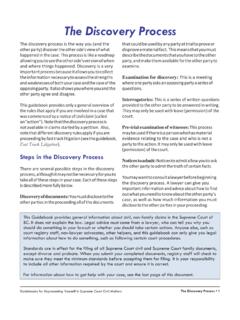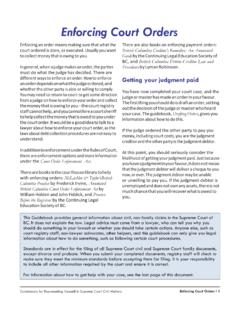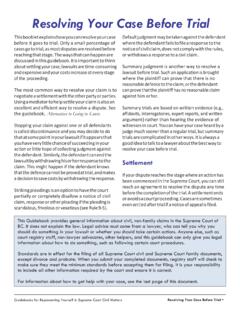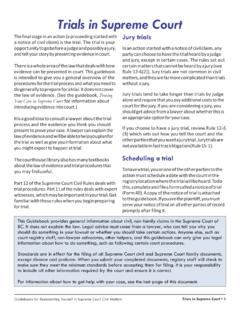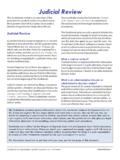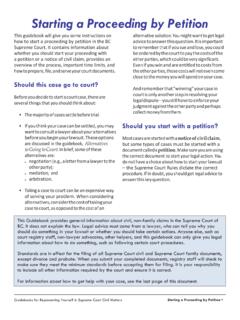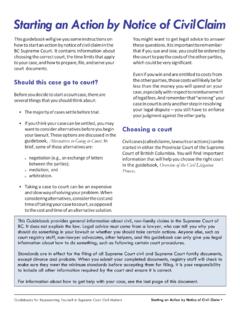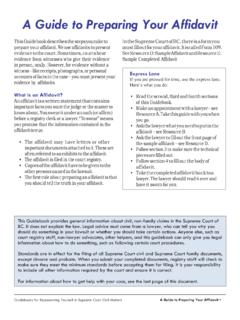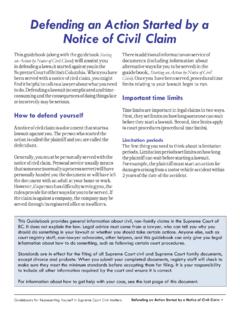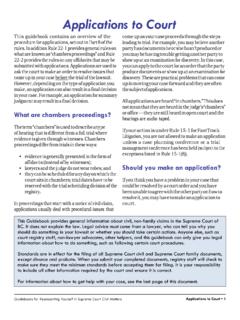Transcription of Costs in the Supreme Court
1 Costs in the Supreme Court This guidebook provides an overview of the procedure for assessing Costs in a Supreme Court action. Costs are usually awarded to the party who is successful at trial. They are intended to be a partial indemnity for legal fees and time spent, plus a reimbursement of proper out-of-pocket expenses that the successful party incurred in starting or defending the lawsuit. The rules that govern Costs are set out in Rule14-1 and Appendix B of the Supreme Court Rules. Read these carefully before preparing your documents. You will also find detailed information about Costs in two books that can be found in the courthouse library: Practice Before the Registrar published by the Continuing Legal Education Society of BC and The Conduct of Civil Litigation in British Columbia by Fraser, Horn and Griffin.
2 You should also consider talking to a lawyer about the issue of Costs . What are Costs ? The Court may award Costs to compensate, at least in part, the successful party for disbursements (out-of- pocket expenses) paid during the action, plus time spent, or legal fees relating to the action. They are called party and party Costs . Therefore, if you are a party to a Supreme Court action and are successful on a chambers application or at trial, you may request that the other party pay your Costs . The general rule is that the amount of Costs is based on the tariff set out in Appendix B of the Supreme Court Rules, plus disbursements.
3 Occasionally, if there has been reprehensible conduct in the course of the action, such as fraud, the Court may order that special Costs be paid to the successful party. Special Costs are higher and approximate actual legal fees. You can apply for special Costs even if you are not represented by a lawyer. Getting an order for Costs You must make a claim for Costs in your notice of civil claim, or in your notice of application, when you make an application in chambers. If you are defending an action or application, you must make a claim for Costs in your response or in your response to an application in chambers. Although you have already made a request for Costs in your pleadings or chambers application, you should ask for Costs as soon as the judge or master hearing the application or the trial rules in your favour.
4 When does the Court assess Costs ? Usually all Costs are assessed at the end of your case, even if you have been successful on a chambers application before trial. In other words, the Costs from the chambers application will not be assessed until the end of the action unless the Court orders that the Costs are to be paid forthwith (immediately). Guidebooks for Representing Yourself in Supreme Court Civil Matters Costs in the Supreme Court 1 This Guidebook provides general information about civil, non-family claims in the Supreme Court of BC. It does not explain the law. Legal advice must come from a lawyer, who can tell you why you should do something in your lawsuit or whether you should take certain actions.
5 Anyone else, such as Court registry staff, non-lawyer advocates, other helpers, and this guidebook can only give you legal information about how to do something, such as following certain Court procedures. Standards are in effect for the filing of all Supreme Court civil and Supreme Court family documents, except divorce and probate. When you submit your completed documents, registry staff will check to make sure they meet the minimum standards before accepting them for filing. It is your responsibility to include all other information required by the Court and ensure it is correct. For information about how to get help with your case, see the last page of this document.
6 Costs may be assessed: when the Court orders Costs to be assessed; if a settlement agreement provides for the payment of Costs to be assessed; when a party has obtained default judgment; by the party whose formal offer to settle has been accepted; by the defendant when the plaintiff discontinues the action; or by the plaintiff when the defendant withdraws their defence. If you obtain an order for Costs after a trial, you can take out an appointment with the registrar to assess the Costs as soon as the order providing for Costs is entered (see the following discussion). Instructions on how to make an appointment with the registrar are explained later in this guidebook.
7 Entering a Court order The party who is successful in a chambers application or at trial is responsible for: drafting the order of the Court ; sending it to the other parties for their signatures. (Note that by signing the order, you are agreeing that the order accurately sets out the terms of the order made by the judge or master. It does not mean that you necessarily agree with the order that was made against you. See the guidebook, Drafting Court Orders.); and submitting the order to the Court so that it can be entered. An order is entered when it has been signed by the parties and processed and stamped by the Court registry.
8 The order must be in the form set out in the Supreme Court Rules (see Rule13-1(3) and Forms 34, 48, and 35). You can find more information about drafting Court orders in the guidebook, Drafting Court Orders. Once an order is entered, a copy will be given to the party who submitted it for entry. That party is responsible for providing a copy of the entered order to the other parties. Preparing a bill of Costs If you are entitled to your Costs of the action as described above, you must prepare a bill of Costs using Form 62 of the Supreme Court Rules. Appendix B of the Rules also gives you important information about preparing your bill of Costs .
9 Tips for preparing your bill of Costs Appendix B to the Supreme Court Rules gives you information about completing your bill of Costs . The following tips will help you prepare your own bill of Costs : Use Form 62. Review the list of tariff items in Appendix B of the Rules. It tells you the categories and items that you can include in your bill of Costs . For each item number, fill in amount of units on the far right or leave the item blank if it does not apply to your case. Do not change the item numbers. Add up your claim for tariff item units to get a total number of units. Multiply the total number of units by the unit value according to the scale of Costs .
10 2 Costs in the Supreme Court Guidebooks for Representing Yourself in Supreme Court Civil Matters When the judge or master made the order for Costs , he or she may have fixed the scale from A to C, which is the scale you will use to calculate your Costs . For example, if the case was not very difficult, the scale may have been fixed at Scale A, which means that you are entitled to claim $60 per unit. However, if the case was very difficult, the scale may have been fixed at Scale C, which means that you may claim $170 for each unit. The value for the scales is set out in section 3 of Appendix B. If the judge or master did not make an order about the scale of Costs in your case, the units are assessed as scale B, which is $ per unit.
